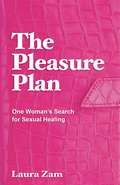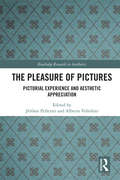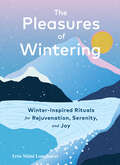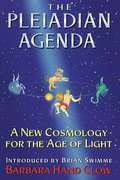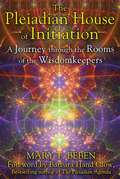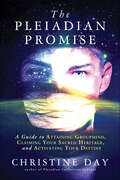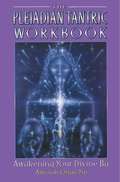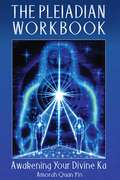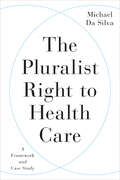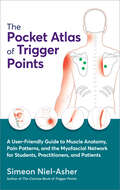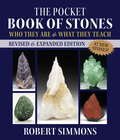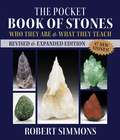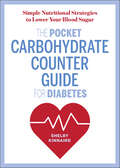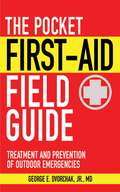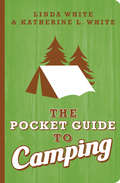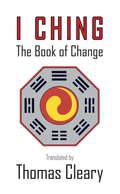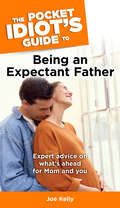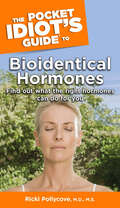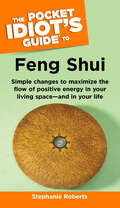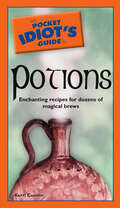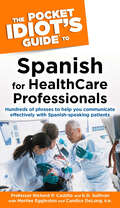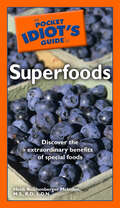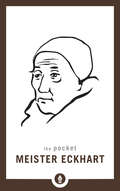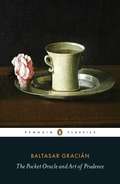- Table View
- List View
The Pleasure Plan: One Woman's Search for Sexual Healing
by Laura ZamBased on popular essays in New York Times&’ Modern Love and Salon, as well as an Off-Broadway one-person play, The Pleasure Plan is a sexual healing odyssey, a manifesto for women to claim pleasure as a priority, and a love story all at once.Fifty percent of adult women have some form of sexual dysfunction at some point of their lives, preventing them from enjoying vibrant, soul-satisfying sex. Such was the case with Laura Zam, who suffered the blame, shame, and embarrassment of feeling bedroom broken. For her, delving between the sheets meant physical pain, zero desire, and emotional scars from being molested in her early years. However, in her late forties, after meeting and marrying the love of her life, Zam was determined to finally fix her sensual self. This is her brave and bawdy plan to triage her flaccid romantic life, stepping into a void where intimacy, self-love, and playfulness could be experienced--the full monty of Eros that had been missing from her existence. The Pleasure Plan is what happened when she decided to challenge her hopelessness. In partnership with her initially reluctant husband, she visited 15 healers and tried 30 pleasure-enhancing methods: from dilators and dildos, to hypnosis and hosting a sex brunch, to cleansing chakras, to making love to her husband in front of a geriatric Tantric goddess. Packed with humor, heart, and a healthy dose of prescriptive advice, this book chronicles Zam&’s insight as she confronts many issues—from mismatched libidos to female erection enlightenment. Throughout this journey, she and her husband grow as individuals and as a couple, both in and out of the bedroom. Fearlessly honest and full of inspiration, Zam peels back the layers—or covers—and exposes her foibles, insecurities, and eventual wisdom as she excavates past traumas, accepts and embraces her worth, and claims her right to be completely alive. Today, Laura works as a sexuality educator, wellness coach, and speaker helping other women who suffer from sexual dysfunction, the effects of trauma, or those who would simply like more pleasure (of all kinds) in their lives. She also consults with health care providers so they may better assist their clients in achieving sexual well-being. While The Pleasure Plan is Zam&’s personal narrative, it demystifies pervasive taboos, encouraging women to make pleasure a priority, while teaching them how to claim (or reclaim) the power of their sexual selves. It also shows men how they can support their partners in this #Metoo era. Healthy, sultry intimacy is a right; it is time for women to learn—through glorious trial and error—how to embrace the sensual side of themselves. . . exuberantly and unabashedly.
The Pleasure of Pictures: Pictorial Experience and Aesthetic Appreciation (Routledge Research in Aesthetics)
by Alberto Voltolini Jérôme PelletierThe general aim of this volume is to investigate the nature of the relation between pictorial experience and aesthetic appreciation. In particular, it is concerned with the character and intimacy of this relationship: is there a mere causal connection between pictorial experience and aesthetic appreciation, or are the two relata constitutively associated with one another? The essays in the book’s first section investigate important conceptual issues related to the pictorial experience of paintings. In Section II, the essays discuss the notion of styles, techniques, agency, and facture, and also take into account the experience of photographic and cinematic pictures. The Pleasure of Pictures goes substantially beyond current debates in the philosophy of depiction to launch a new area of reflection in philosophical aesthetics.
The Pleasures of Wintering: Winter-Inspired Rituals for Rejuvenation, Serenity, and Joy
by Erin Niimi LonghurstThe Pleiadian Agenda: A New Cosmology for the Age of Light
by Brian Swimme Barbara Hand ClowNoted astrologer and spiritual teacher Barbara Hand Clow channels the voice of Satya, a Pleiadian goddess. Satya describes the huge cosmic drama taking place simultaneously in nine dimensions, with Earth as the chosen theater. The Pleiadians are a group of enlightened beings who believe that the end of the Mayan Calendar will signal a critical leap in human evolution; the Pleiadians will be there to guide us for that leap. This shift is the coming Age of Light, and the entry of our solar system into the Photon Band and the Age of Aquarius.
The Pleiadian House of Initiation: A Journey through the Rooms of the Wisdomkeepers
by Barbara Hand Clow Mary T. BebenA step-by-step tour through our spiritual home in the Pleiades • Recounts the author’s spiritual trials to reach the highest levels of her soul’s celestial mansion and her encounters with immortal wisdom teachers such as White Buffalo Woman, Taliesin, Mother Mary, and Grandmother Spider • Includes lessons to help jettison fear and jealousy so we can continue our ascension to higher consciousness • Offers a prophetic glimpse into the future of life on Earth, how our planet is the key to conscious evolution, and humanity’s divine role as Keepers of Earth Inviting each of us to discover our spiritual home in the higher realms, Mary Beben provides a visionary tour of the celestial mansion of her family in the Pleiades, a home she inhabited prior to this incarnation on Earth. She explains how transitioning into materiality causes each of us to forget our starry origins, yet it is still possible to remember our Pleiadian heritage and divine reasons for choosing to manifest on Earth. Beben details her initiatic journey as she rediscovered the beautiful rooms on each floor of her Pleiadian house and learned to ascend to higher consciousness while remaining lovingly rooted in the Earth. She recounts her trials to reach the higher levels of the building and her encounters with immortal wisdomkeepers such as White Buffalo Woman, Taliesin, Mother Mary, and Grandmother Spider. Embedded throughout her story are lessons to help each of us jettison psychological baggage like fear and jealousy so we can continue our ascension and fulfill our Pleiadian birthright. Beben explains how her journey offers a prophetic glimpse into the future of life on Earth as well as the key to opening the heart to the higher realms of existence. She shows how ascension will not mean departing Earth but will place our Earthen reality in perspective and help solve problems that seem insurmountable from this dimension. In rediscovering the celestial origins of our souls, we recognize not only the Earth as the key to conscious evolution but also our role as the Keepers of Earth, the planet celebrated throughout the universe on which each of us is fortunate to have chosen incarnation.
The Pleiadian Promise: A Guide to Attaining Groupmind, Claiming Your Sacred Heritage, and Activating Your Destiny
by Christine DayThe Pleiadians are moving into a new era. Through the opening of a new multidimensional timeframe, a pure light frequency has activated the sacred timing of an important aspect of their commitment to us as a human race.This is what the Pleiadians refer to as fulfilling the Promise that was set in place lifetimes ago. Now is the time for them to reveal to us as a human race the sacred aspects of who we are and what we need to do to become fully realized and fulfill our role on our Earth plane.The energy of this Promise holds the key to our further awakening and the unfolding of our self-realization process on a multidimensional level. This Promise activates the revelations of understanding and knowledge to be given to all those who are seekers of Truth--information that will help us to understand this transition and the role we need to play to fully open ourselves to our magnificence.A series of blessed revelations align you to a deeper natural aspect of your own humanness and spirituality. The Pleiadian Promise also includes six channeled audio files that give you a direct experience with the Pleiadians through multidimensional levels of light initiations.
The Pleiadian Tantric Workbook: Awakening Your Divine Ba
by Amorah Quan YinThe Pleiadian Tantric Workbook assists you with healing relationships. This sequel to The Pleiadian Workbook teaches advanced cellular clearing to heal the male/female split, and, with specific exercises and techniques practical for everyday life, shows you how to activate and clear kundalini and sexual channels through tantra.
The Pleiadian Workbook: Awakening Your Divine Ka
by Amorah Quan YinThe Pleiadian Workbook is a direct transmission from the Pleiadian Emissaries of Light--Light beings from the Pleiades--who say it's time now for spiritual growth, ascension, and healing. Through Amorah Quan Yin, we are taught to open our "Ka Channels," which pull energy from our multidimensional, holographic selves into our physical bodies. These galactic healing techniques align us with our divine selves, raise our vibratory rates, and rejuvenate and balance our bodies, while accelerating spiritual evolution and stimulating emotional healing.
The Plot Against the Kids: A True Covid Story
by Simone GoldIn 2020, Dr. Simone Gold was a frontline emergency physician treating patients in the hospital, just as she had done for twenty years. She spent her days performing life-saving procedures, counseling patients, and treating complex illnesses. But then, amidst rumors of a new and terrifying virus spreading across the world, things began to change. Suddenly, doctors were not allowed to treat patients the way they always had. Long-held medical wisdom was thrown out the window, and there were strange new rules that everyone was expected to follow. The government ordered citizens to mask their faces, hide in their homes, and fear their neighbors. Children were pulled out of school and forbidden from playing with their friends. But why? The Plot Against Kids tells the real story of the Covid-19 pandemic in a charming, accessible way, and helps young ones understand the tyranny that gripped our world in the absence of scientific curiosity, critical thinking, and common sense. This remarkable story inspires kids to trust their own intuition, reject fear-based decision-making, and embrace a bright and hopeful future. Because after all, parents are meant for loving, children are meant for playing, and faces are meant for seeing!
The Pluralist Right to Health Care: A Framework and Case Study
by Michael DaSilvaHealth rights are a common but controversial legal phenomenon. Every country is signatory to a treaty that incorporates health rights, yet existing health rights do not fit easily into the traditional "claim right" model, and questions remain over how to theoretically incorporate health rights into domestic systems. The Pluralist Right to Health Care addresses this incongruity between theory and practice with an account of the right to health care that is both philosophically and practically sound. Utilizing a pluralist framework, Michael Da Silva argues that the right to health care is best understood as a set of claims to related ends: the goods necessary for a dignified existence, procedural fairness in determining what other goods to provide and in the provision of goods, and a functioning health care system. Through philosophical reasoning, analysis of relevant international human rights law, and a close study of the Canadian case, The Pluralist Right to Health Care provides crucial insight into the potential of law and policy to improve health care systems in Canada and beyond.
The Pocket Atlas of Trigger Points: A User-Friendly Guide to Muscle Anatomy, Pain Patterns, and the Myofascial Network for Students, Practitioners, and Patients
by Simeon Niel-AsherA simple, go-to guide to treating chronic pain with trigger point therapy for physical therapists, bodyworkers, and patients From the bestselling author of The Concise Book of Trigger PointsThis pocket-sized guide covers practical information about the trigger points—the painful knots that can form in tissues like muscles and fascia—that are central to addressing chronic pain with massage, bodywork, and physical therapy. Full-color illustrations and charts help practitioners, students, and patients identify trigger points and address referred pain patterns with ease.The first chapter introduces relevant information on fascia and myofascial meridians and provides an overview of trigger point symptoms, classification, and formation. Subsequent chapters are organized by muscle group and feature concise—yet comprehensive—sections on each of the main skeletal muscles and their trigger points. Conditions that commonly occur in the general population, such as headaches and back pain, are explored for all of the muscle groups, including the muscles of the:Face, head, and neckTrunk and spineShoulder and armForearm and handHip and thighLeg and footWritten in clear, accessible language, this go-to guide offers a wealth of knowledge to the lay reader, the student, or the practitioner.
The Pocket Book of Stones, Revised Edition: Who They Are and What They Teach
by Robert SimmonsThe spiritual and healing qualities of 390 members of the mineral kingdom are detailed here in The Pocket Book of Stones, Robert Simmons's condensed reference guide to to crystals and gems. Based on the bestselling The Book of Stones: Who They Are and What They Teach, this guide describes 47 new stones not covered in the original encyclopedia and also contains an index of the spiritual, emotional, and healing qualities of the stones.This pocket edition has been requested by many readers who are looking for a compact reference that they can carry easily or give as an inexpensive gift to the rock-lovers on their gift lists. Incorporating beautifully lit, full-color photos of each stone, it imparts the spiritual understanding that made The Book of Stones the "bible" of many thousands of crystal lovers.This book is an ideal introduction to stones and their energies for those who are new to the field, as well as being an invaluable portable reference for well-versed readers. Every entry contains a vivid color photo and quick-look list of key words, elemental and chakra correspondences, plus the beneficial physical, emotional, and spiritual qualities of each mineral, crystal, or gemstone. Below the quick-look list, Simmons provides a description of each stone, including scientific data and the story of each stone's spiritual and healing qualities, as well as recommednations for other stones that combine harmoniously with it. The scientific information offered welcomes those not yet familiar with crystal energies by providing a familiar frame of reference and also broadens the knowledge of those who come to stones primarily for spiritual purposes.The Pocket Book of Stones includes a comprehensive index of the healing qualities and the emotional and spiritual properties of all the stones in the book.From the Trade Paperback edition.
The Pocket Book of Stones: Who They Are and What They Teach
by Robert Simmons• Features beautifully lit, color photos of each stone to aid in identification and to showcase the beauty of the crystals and gemstones • Provides a description of each stone, a quick-look list of keywords, elemental and chakra correspondences, scientific data, and the story of each stone&’s beneficial physical, emotional, and spiritual qualities • Based on the bestselling The Book of Stones: Who They Are and What They Teach Detailing the spiritual and healing qualities of 390 members of the mineral kingdom, The Pocket Book of Stones is condensed reference guide to crystals and gems based on the bestselling The Book of Stones: Who They Are and What They Teach. This portable A-to-Z guide features beautifully lit, full-color photos of each stone to aid in identification and to showcase the beauty of the crystals and gemstones. This updated edition describes 47 new stones not covered in the original Pocket Book of Stones and contains a comprehensive index of the spiritual, emotional, and healing qualities of the stones. Every entry contains a vivid color photo, quick-look list of keywords, elemental and chakra correspondences, plus the beneficial physical, emotional, and spiritual qualities of each mineral, crystal, or gemstone. Author Robert Simmons provides a description of each stone, including scientific data and the story of each stone&’s spiritual and healing qualities, as well as recommendations for other stones that combine harmoniously with it. The scientific information offered provides a familiar frame of reference for those not yet familiar with crystal energies and also broadens the knowledge of those who come to stones primarily for spiritual purposes. This book provides an ideal introduction to stones and their energies for those who are new to the field as well as an invaluable portable reference for well-versed readers.
The Pocket Carbohydrate Counter Guide for Diabetes: Simple Nutritional Strategies to Lower Your Blood Sugar
by Shelby KinnairdThe Pocket Carbohydrate Counter Guide for Diabetes offers the simplest, most accurate strategies for counting carbs and lowering your blood sugar.When you have a strategy for counting carbohydrates, you don't need to consult lists of nutritional information every time you sit down to eat. The Pocket Carbohydrate Counter Guide for Diabetes makes it easy to manage diabetes in your daily life with simple nutritional strategies to accurately count carbs and maintain normal blood sugar levels.Written for recently-diagnosed and long-time diabetes patients alike, this handy pocket reference is a simple solution to eliminate guesswork and confidently judge the carbs in every meal. From setting targets and finding your personal sweet spot, to actionable strategies like meal planning, this carbohydrate counter book makes counting carbs as easy as 1,2,3.Never overestimate or underestimate carbs again. This carbohydrate counter book keeps your blood sugar levels in check with:Effective tools for counting carbs with clear, step-by-step instructions and illustrations for accurately measuring carbs, plus alternative methods such as meal planning and balancing your plateLifestyle advice that includes recommendations for smart snacking, and offers tips on what to order while eating outAn introduction on the connection between carbs and diabetes that provides an in-depth look at what happens in your body when you eat carbs, and an overview of foods that contain (and hide) carbsStop guessing—learn simple strategies for counting carbohydrates and lower your blood sugar with this carbohydrate counter book.
The Pocket First-Aid Field Guide: Treatment and Prevention of Outdoor Emergencies (Skyhorse Pocket Guides)
by George E. DvorchakPractical advice for the on-the-go outdoorsman, this field-friendly guide is essential for anyone interested in first-aid preparation and care. Here is advice useful on a hike or for any fishing trip, including step-by-step instructions on dealing with fractures, suturing wounds, treating eyes and ears, managing allergic reactions, and more. With common sense advice, and in a handy, portable package, this is one little book that no one should be without in a campsite or in their forest hideaway.
The Pocket Guide to Camping
by Linda White Katherine L. WhiteA kid&’s guide to camping, including everything from first aid skills to fun campfire songs and recipes. The Pocket Guide to Camping has all the camping basics for kids—or beginners of any age—from setting up a tent to hiking a trail to cooking over the campfire. The book covers camping skills and first aid, along with stories, games, activities, and campfire songs. It also includes great campfire recipes that kids can make. This inclusive, family-oriented guide takes you through planning your trip to getting home safely—and is chock full of information and fun ideas.
The Pocket I Ching: The Book of Change
by Thomas ClearyThe I Ching (Book of Change) is considered the oldest of the Chinese classics, and has throughout Chinese history commanded unsurpassed prestige and popularity. Containing several layers of text and given numerous levels of interpretation, the I Ching has been venerated for more than three thousand years as an oracle of fortune, a guide to success, and a source of wisdom. The underlying theme of the text is change, and how this fundamental force influences all aspects of life--from business and politics to personal relationships. This translation of the I Ching draws on ancient Confucian commentary, which emphasizes applying practical wisdom in everyday affairs.
The Pocket Idiot's Guide to Being An Expectant Father
by Joe KellyFrom the home pregnancy test to handing out cigars . . . and beyond. Dads-to-be often worry more than they let on about the emotional, financial, and physical changes that come with their partners&’ pregnancies. The Pocket Idiot&’s Guide® to Being an Expectant Father shows you how to get ready for the most important role of your life. In this Pocket Idiot&’s Guide®, you get: • Idiot-proof tips on setting up the nursery and babyproofing your home. • Straight talk on how having a baby will impact your finances—and what you can do to prepare. • A trimester-by-trimester account of changes in both baby and mom. • Practical ways to get attuned to your baby&’s schedule—and bond with the little one, too!
The Pocket Idiot's Guide to Bioidentical Hormones
by Nancy Faass Ricki PollycoveFor the first time in history, millions of women have the opportunity to grow old as vigorous, vitally engaged, and productive people. Advances in health care and medical knowledge now offer a solid foundation for those who want to reduce their health risks and improve their quality of life. Wise use of estrogen can lower a woman's risk of colon cancer, osteoporosis, hip fractures, heart disease, and dementia, yet fewer than 17 percent of American women for whom hormone supplements are appropriate actually take them. Bioidentical hormones are created from plant molecules identical to those found in the human body. These new hormones provide women with another resource to meet the needs of aging-saftey when used intelligently. The Pocket Idiot's Guide® to Bioidentical Hormones provides the evidence on what is safe and what is not and presents a wide range of options for supplementing hormones, within an easy-to-answer discussion of Hormone Replacement Therapy in general. Completely objective, the book answers all the questions and coverage includes: • The case for hormones-bioidentical or otherwise • The safety issue-which hormones work and which may be harmful • Bioidentical hormones-beneficial effects on the heart, bones, and brain • Creating an individualized health plan-which hormones, in what combination-how much and how often
The Pocket Idiot's Guide to Feng Shui
by Stephanie RobertsHow to maximize chi—inside and outside the home. This illustrated guide to the ancient Chinese art strips feng shui down to the basics, focusing solely on those aspects that deal with the interior and exterior of one&’s home. Author Stephanie Roberts shows readers how to evaluate and change aspects of their space to maximize the flow of positive energy, and how to arrange each room to achieve better balance in their lives and increase their prospects for health, wealth, and good relationships. The Pocket Idiot&’s Guide® to Feng Shui will show you exactly how to analyze your living area—room by room—and arrange it to benefit not only your mind and body, but also your spirit. In this Pocket Idiot&’s Guide®, you get: • The basic philosophy of feng shui, including ba gua energy map, the eight areas of influence, and the five transformation. • Tips on how to channel good chi in every room of your home. • Practical advice on eliminating the negative influence clutters into your home and your life. • An understanding of the positive relationship between housework and feng shui.
The Pocket Idiot's Guide to Potions: Enchanting Recipes for Dozens of Magical Brews
by Kerri ConnorMake your own magic. You&’re no idiot, of course. You&’re a big believer in the power of potions to help your wishes come true. But when you try to brew your own special concoctions, you&’re missing that magic touch. Don&’t get all mixed up! Pick up The Pocket Idiot&’s Guide® to Potions for a potent blend of advice and recipes. In this Pocket Idiot&’s Guide®, you get: • Easy ways to harness your magical energy—and use it to improve your life. • An otherworldly overview of the properties of different plants and herbs. • Practical techniques for making your own oils, lotions, teas, and tinctures. • Tantalizing tips on using cauldrons, censers, vials, and other tools of the trade.
The Pocket Idiot's Guide to Spanish For Health Care Professionals
by K.D. Sullivan Prof. Richard P. CastilloFor health workers serving a growing community. Today, when one in four babies born in the US is Hispanic, it is essential that every hospital administrator, nurse, EMT, and doctor have a working knowledge of Spanish. Chapters include vocabulary, phrases, and pronunciation for everything from insurance forms to mental health to prenatal care, with additional sections on dentistry and optometry. • Essential reference for doctors, nurses, EMTs, nursing home staff, home caregivers, volunteers, hospice nurses, and administrators. • Perfect size for a lab coat pocket. • Author is an experienced linguist with experience in teaching health care–related Spanish courses.
The Pocket Idiot's Guide to Superfoods: Discover the Extraordinary Benefits of Special Foods
by Heidi McIndooMove over, fad diets! With the fading novelty—and declining popularity—of such fad diets as South Beach and Atkins, many people are turning to sensible, moderate eating habits. Along with this trend is an interest in superfoods, those foods that not only nourish the body, but also help fight disease. This pocket guide covers 30 disease-fighting, healthful superfoods and provides simple explanations of how they work. - Includes coverage of 30 superfoods—more than other book.
The Pocket Meister Eckhart (Shambhala Pocket Library)
by Dave O'NealAn introduction to the writing and preaching of the greatest medieval European mystic.Meister Eckhart (1260–1327), a German Dominican whose preaching was immensely popular in his own time, was one of the greatest medieval European mystics, and his writings helped build the foundation of the Western mystical tradition. This important introduction to his writing and preaching contains rich selections from his sermons, treatises, and sayings, as well as Table Talk, the records of his informal advice to his spiritual children. This book was previously published under the title Meister Eckhart, from Whom God Hid Nothing: Sermons, Writings, and Sayings.The Shambhala Pocket Library is a collection of short, portable teachings from notable figures across religious traditions and classic texts. The covers in this series are rendered by Colorado artist Robert Spellman. The books in this collection distill the wisdom and heart of the work Shambhala Publications has published over 50 years into a compact format that is collectible, reader-friendly, and applicable to everyday life.
The Pocket Oracle and Art of Prudence
by Baltasar GraciánWritten over 350 years ago, The Pocket Oracle and the Art of Prudence is a charming collection of 300 witty and thought-provoking aphorisms. From the art of being lucky to the healthy use of caution, these elegant maxims were created as a guide to life, with further suggestions given on cultivating good taste, knowing how to refuse, the foolishness of complaining and the wisdom of controlling one's passions. Baltasar Gracian intended that these ingenious aphorisms would encourage each reader to challenge themselves both in understanding and applying each axiom.
